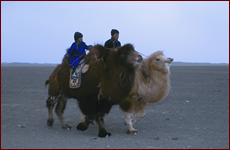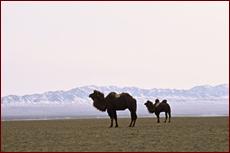The Mongolian Desert

Population:

Mongolia is in the heart of Central Asia, between Russia and China. It is a huge country, with an area of around 1.5 million square kilometres, but has a very low population - only 2.4 million. 70% of the population are under 35 years old, and the average age is only 21. Just over half of people live in towns and cities, with the other 47% still living the nomadic lifestyle, which has remained virtually unchanged for hundreds of years. Mongolian children and young people are very well educated - the overall literacy rate is 97%. 500,000 children are taught at 600 schools, and around 100,000 students go to University and college.
Capital:
The capital city of Mongolia is called Ulaanbaatar, which means Red Hero, and is the main centre of political, financial and business life. Around one third of the total population of Mongolia live here.
Climate:
Mongolia has a very dry, harsh climate, due to its elevation above sea level and distance from seas. It may only rain every few years, so water is a precious commodity. The temperature can change dramatically and the desert can be swept by very strong winds of up to 140km/hour. In winter the temperature can fall as low as minus 30°C and in summer it can rise up to 50°C.

Environment:
The Gobi Desert makes up more than 400,000 square km of Southern Mongolia, which mostly consists of rocky mountains and valleys. The desert has a real variety of landscapes, from mountains to flat areas of arid desert, oases with palm trees to sand dunes. It is generally quite barren but it does sustain various wildlife: goats and camels are domesticated, and snow leopard, wild sheep and goats, wild horses, antelopes and the desert bear are all found here.
Political Background:
Mongolia won its independence from China in 1921 with Soviet backing. A Communist regime was installed in 1924. During the early 1990s, the Communists gradually gave over their power to a Democratic party, the DUC, which eventually defeated the Communist party in the election of 1996. The DUC have reformed the Mongolian political and economic systems and made the country much more democratic.
Natural Resources:
Oil, coal, copper, tungsten (used to make a type of steel), phosphates, tin, nickel, zinc, gold, silver, iron.
Industry:
construction materials, mining (coal, copper, molybdenum, fluorspar, and gold); oil; food and beverages, processing of animal products.
